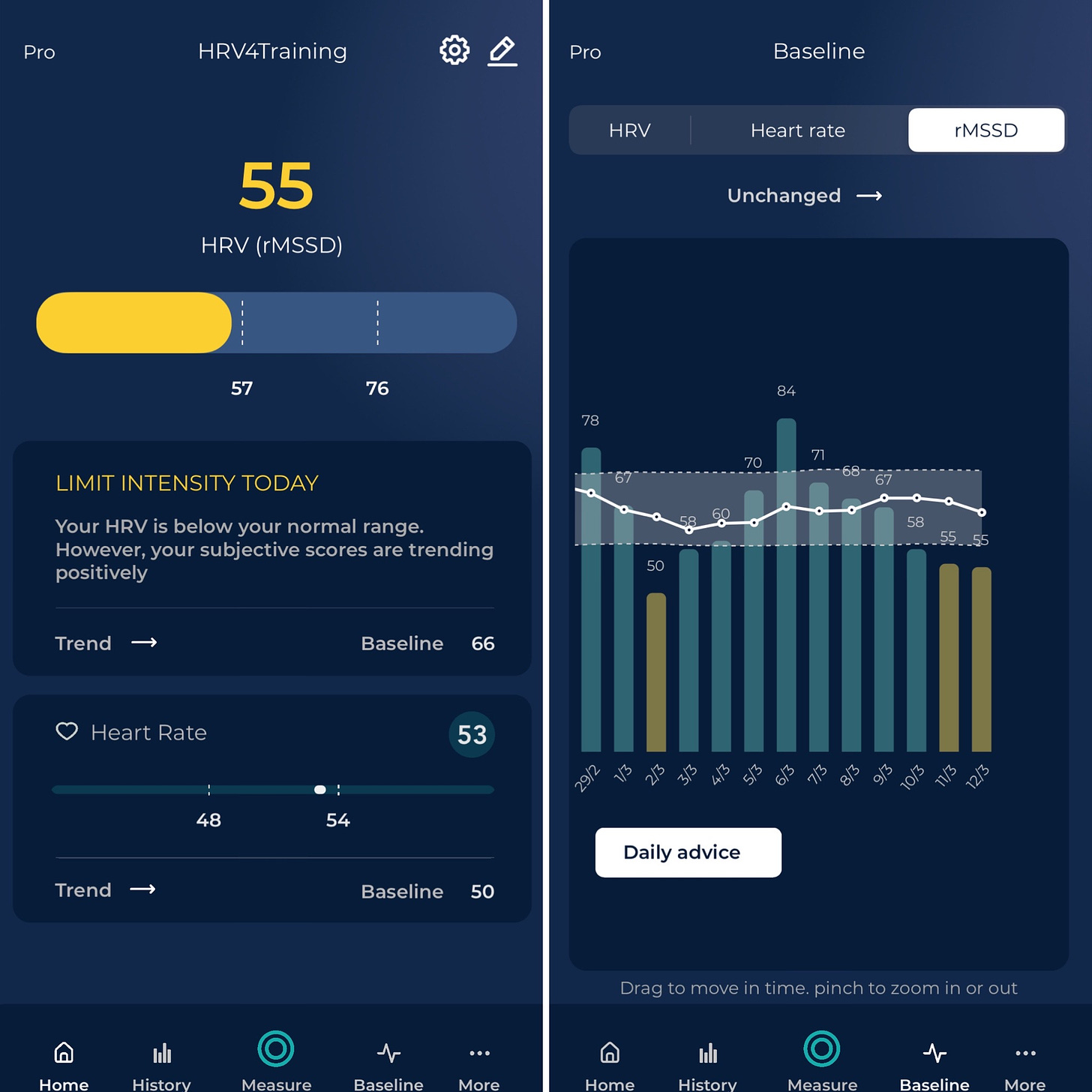One of the most interesting things about HRV is that it does not represent stress. It represents our response to stress.
This is the case when we measure HRV according to best practices, i.e. far from stressors, ideally in the morning, but possibly also in the night, if we have a quiet evening routine.
When HRV is stable, it means that we have responded well to stressors, and re-normalized quickly. It doesn’t mean that we are not experiencing stress.
It is perfectly normal for HRV to be suppressed during a stressor (no need to look at HRV in that case, as an elevated heart rate will already show it clearly). HRV becomes useful only when used to assess our response, i.e. when measured hours after the stressors. If we have responded well, HRV will be back to normal. If we have not responded well, or we have multiple stressors to deal with, HRV will be still suppressed.
Measuring with a good protocol, at regular time intervals (i.e. first thing in the morning or in the night) is much more informative than looking at data all the time. I discussed continuous data before (see here), but I want to reiterate that continuous data:
is poor quality, especially if “measured” with optical sensing. It is not possible to measure HRV with optical sensors if you move (even just moving a muscle, e.g. while typing, makes it impossible to measure HRV accurately). Example here.
is artifacted by all sort of things that have nothing to do with stress: for example, swallowing saliva, yawning, drinking water, etc.. The link between parasympathetic actiity and HRV, is not valid, outside of certain protocols. HRV is not vagal or parasympathetic activity, but depends on a myriad of unrelated processes. Example here.
doesn’t mean anything in terms of the chronic effect of stress: for example, exercise is “bad” acutely, but good chronically, how many stressors are flagged as bad by continuous “stress” monitors that have no idea about the long-term exposure to such stressors?.
transform any normal physiological response into something pathological: stress is not bad, hence it is perfectly fine to be exposed to stress, what matters is how we respond to it, and how we can adjust our behavior to improve our response: this is why we should measure the response, which is done hours after the stressors, not continuously.
Sadly, these days I find myself discussing these aspects all the time, as opposed to discussing how to actually use HRV effectively. Thanks, wearables.
Back to our main topic for this blog post: when we see a negative response to stress (e.g. a suppressed HRV below our normal range, for a few days), what shall we do?

Common sense says we have two options:
Reduce stressors
Increase recovery
Reducing stressors is feasible at times, for example, in the context of training, this is as simple as reducing training intensity. For non-training-related stressors, things might be more complex, and option 2) might also help. An example of 2) could be sleeping more or taking a nap, or eating better.
Reducing stressors and increasing recovery are not mutually exclusive, of course, and we can also try to do both at the same time, as it often happens in life.
In sports science, there are quite a few studies covering 1), and typically showing either no change or improved performance when limiting training intensity on days or weeks in which HRV is suppressed. Stressor timing matters, and "losing" a few hard sessions does not seem to be as detrimental as doing them while in a negative stress state (see Javaloyes et al, or Vesterinen et al).
However, I haven't seen much (any?) research for 2) in terms of interventions using HRV. Is performance improved if we keep our hard sessions but e.g. try to get some more sleep, or eat better, etc. ?
I'm aware of many coaches using these strategies in professional sports (e.g. using HRV and trying to focus on the "increasing recovery" side of things, more than on "limiting stressors", which might not be an option with frequent games or other constraints), but it'd be nice to see some systematic studies on this.
What are your strategies?
Have you been able to study them systematically in the long run?
Marco holds a PhD cum laude in applied machine learning, a M.Sc. cum laude in computer science engineering, and a M.Sc. cum laude in human movement sciences and high-performance coaching.
He has published more than 50 papers and patents at the intersection between physiology, health, technology, and human performance.
He is co-founder of HRV4Training, advisor at Oura, guest lecturer at VU Amsterdam, and editor for IEEE Pervasive Computing Magazine. He loves running.
Social:
Twitter: @altini_marco.
Personal Substack.




